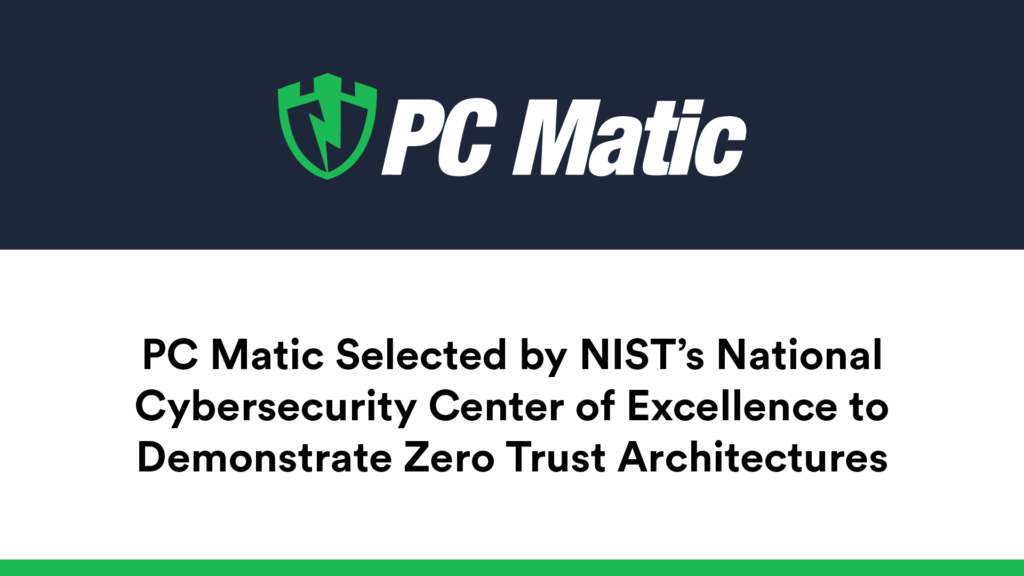PC Matic amongst group of firms chosen to participate; Cybersecurity firm will help develop practical approaches to designing and implementing zero-trust architectures; Approaches will be published in cybersecurity practice guide by NISTΓÇÖs NCCoE
Myrtle Beach, SC ΓÇô Today, American cybersecurity firm, PC Matic, announced it has been selected by the National Institute of Standards and TechnologyΓÇÖs (NIST) National Cybersecurity Center of Excellence (NCCoE) to participate in their Implementing a Zero Trust Architecture Project.
A collaboration amongst many industry leaders in cybersecurity, PC Matic will join seventeen other companies to develop practical approaches to designing and implementing zero-trust architectures. The approaches designed by theseorganizations will result in a cybersecurity practice guide published by the NCCoE for government and enterprise organizations who seek to implement a zero-trust architecture.
ΓÇ£Since inception, PC Matic has utilized a zero-trust approach to stop malicious cyber threats such as ransomware,ΓÇ¥ said PC Matic CEO Rob Cheng. ΓÇ£Understanding just how effective this framework has been for our own customers, we are very grateful to the NCCoE for the opportunity to contribute to this project. We look forward to working together with the NCCoE and our other project partners to showcase the capabilities of and implementation strategies for zero trust architectures.ΓÇ¥
Through its engagement in the project, PC Matic will assist the NCCoE in achieving the programΓÇÖs objectives:
- Demonstrate an example implementation(s) of a Zero Trust Architecture (ZTA), using commercially available technology components designed and deployed according to the zero trust concepts and tenets described in National Institute of Standards and Technology (NIST) Special Publication (SP) 800-207, Zero Trust Architecture.
- Demonstrate various types of user access to enterprise resources (e.g., data sources, computing services, and IoT devices) spread across boundaries, from on premises to multiple cloud environments, all confined by policy based security constraints orchestrated by leveraging zero trust principles and approaches.
- Publish a NIST Cybersecurity Practice Guide, a publicly available description of the practical steps needed to implement a cybersecurity reference design that addresses this challenge.
ΓÇ£Implementing a zero-trust architecture has become a federal cybersecurity mandate and a business imperative,ΓÇ¥ said Natalia Martin, Acting Director of the NCCoE. ΓÇ£We are excited to work with industry demonstrating various approaches to implementing a zero-trust architecture using a diverse mix of vendor products and capabilities, and share ΓÇÿhow toΓÇÖ guidance and lessons learned from the experience.ΓÇ¥
In response to an open call in the Federal Register, PC Matic submitted its capabilities as it relates to the Implementing a Zero Trust Architecture Project. Following such submission, PC Matic was invited to sign a Cooperative Research and Development Agreement with the National Institute of Standards and Technology (NIST), allowing them to participate in this project.
More information on the project may be found here.
###
About the National Cybersecurity Center of Excellence
The NCCoE, a part of NIST, is a collaborative hub where industry organizations, government agencies, and academic institutions work together to address businessesΓÇÖ most pressing cybersecurity issues. This public-private partnership enables creation of practical cybersecurity solutions for specific industries, as well as for broad, cross-sector technology challenges. Through consortia under CRADAs, including technology partnersΓÇöfrom Fortune 50 market leaders to smaller companies specializing in information technology and operational technology securityΓÇöthe NCCoE applies standards and best practices to develop modular, easily adaptable example cybersecurity solutions by using commercially available technology. The NCCoE documents these example solutions in the NIST Special Publication 1800 series, which maps capabilities to the NIST Cybersecurity Framework and details the steps needed for another entity to re-create the example solution. The NCCoE was established in 2012 by NIST in partnership with the State of Maryland and Montgomery County, Maryland. Information is available at https://www.nccoe.nist.gov.
About PC Matic
Founded in 1999, PC Matic is an American cybersecurity software solution provider headquartered in Myrtle Beach, South Carolina. PC Matic operates remotely with employees across the United States and was originally established with the sole purpose of creating a better way to diagnose common computer problems. As cyber threats began to evolve, the company developed its patented globally automated whitelist technology. This technology provides users with essential security that enhances the zero-trust model, fills potential gaps left by traditional endpoint protection software solutions, and provides an additional layer of protection from increasingly complex cyber threats. PC MaticΓÇÖs holistic approach to cybersecurity, application allowlisting, is now the recommended gold standard for cybersecurity and ransomware prevention. The technology is recommended by CISA, NIST, the FBI, and thought leaders and scholars within the field of cybersecurity. PC Matic also features remote monitoring and management capabilities, fileless malware detection, and RDP port protection from brute force attacks. Together, these technologies provide the best security protection for organizations of all sizes and their endpoint devices via its economical and efficient cloud-based platform.
